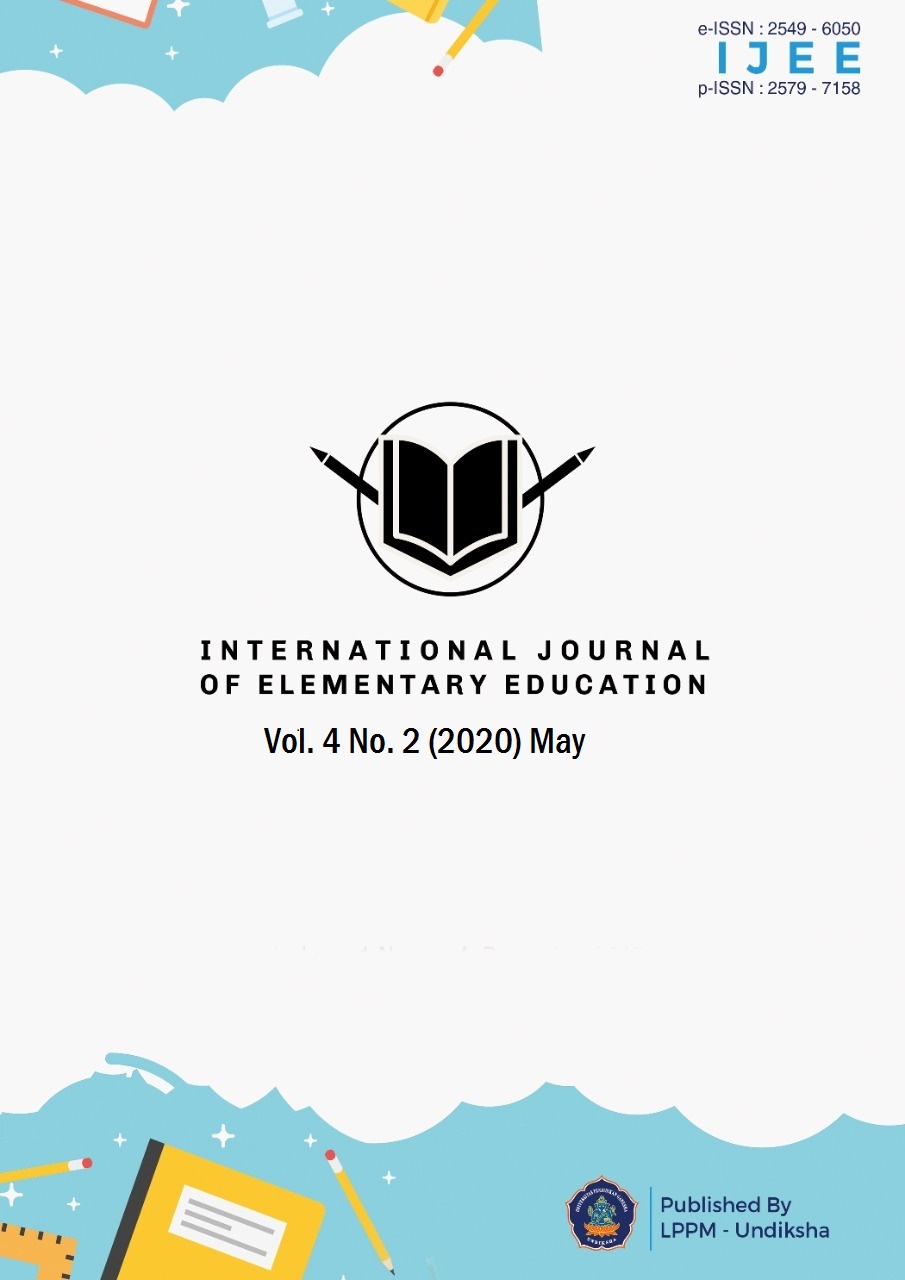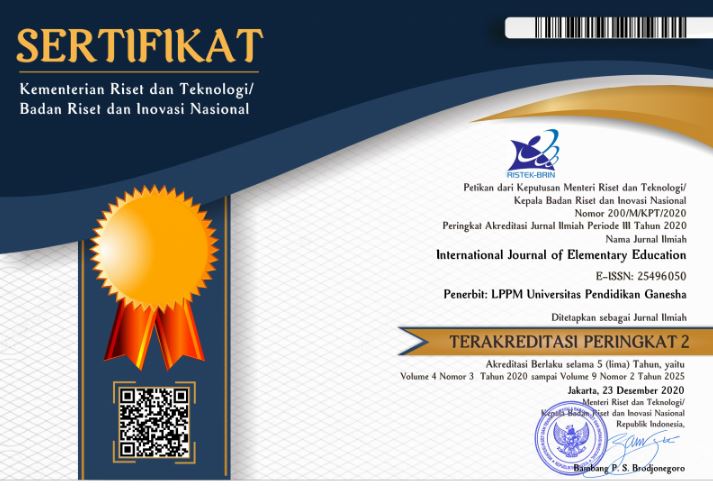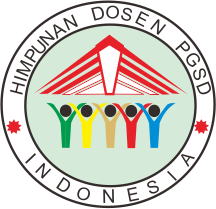Alat Gerak hewan dan Manusia Dikemas dalam Media Pop-Up Book
DOI:
https://doi.org/10.23887/ijee.v4i2.24493Keywords:
pop-up book, alat gerak, ADDIEAbstract
This research is based because the book used by teachers and students in the learning process is still limited, especially in the science material and the display of the book is also less attractive, making it difficult for teachers to explain the material and students become less understanding about the material described, causing student understanding to decrease, in addition, the lack of media use and development also underlies this research. This research aims to develop pop-up book media on the topic of animal and human motion equipment. This research is a development research that uses ADDIE development model which consists of stages (1) analysis, (2) design, (3) Development, (4) implementation, and (5) evaluation. However, this research is only limited to the development stage., the stages of implementation and evaluation were not carried out due to time, resources and financial limitations. The subject in this research is the pop-up book media on the topic of animal and human motion equipment, while the object of this study is the validity of the pop-up book media on the topic of animal and human motion equipment. The method used in the assessment of pop-up book media is a questionnaire method by providing an assessment sheet to two teachers and two lecturers who are experts in their fields. In the validity test activities of the pop-up book media produces data in the form of numbers which are calculated on average scores then converted into a five-scale guideline table. The average value of the validity of the pop-up book media obtained was 4.87 with very good qualifications. Based on this analysis it can be concluded that the development of the pop-up book media on the topic of animal and human motion equipment declared valid.References
Agung, Anak Agung Gede. 2014. Metodologi Penelitian Pendidikan. Malang: Aditya Media Publishing.
Anggraini, dkk. 2019. "Development of Pop-Up Book Integrated with Quranic Verses Learning Media on Temperature and Changes in Matter". Journal of Physics, (hlm 1–9).
Atapukang, Nurmasa. 2016. "Kreatif Membelajarkan Pembelajaran dengan Menggunakan Media Pembelajaran yang Tepat Sebagai Solusi dalam Berkomunikasi". Jurnal Media Komunikasi Geografi, Volume 17, Nomor 2 (hlm. 45–52).
Darmadi, Hamid. 2015. "Tugas, Peran, Kompetensi, Dan Tanggung Jawab Menjadi Guru Profesional". Jurnal Edukasi, Volume 13, Nomor 2 (hlm. 161–174).
Dewanti, Handaruni., dkk. 2018. "Pengembangan Media Pop-Up Book untuk Pembelajaran Lingkungan Tempat Tinggalku Kelas IV SDN 1 Pakunden Kabupaten Ponorogo". JKTP, Volume 1, Nomor 2 (hlm. 221–228).
Fadillah, Rachmadini Nur & Ika Lestari 2016. "Buku Pop-Up untuk Pembelajaran Bercerita Siswa Sekolah Dasar". PERSPEKTIF Ilmu Pendidikan, Volume 30, Nomor 1 (hlm. 21–26).
Fitriani, Lutfi & Khusnul Fajriah. 2017. "Pengembangan Media Pop-Up Book Tema 5 Pahlawanku pada Model Pembelajaran Number Head Together Kelas IV SDN 01 Gintung". Kalam Cendekia, Volume 6, Nomor 3 (hlm. 29–34).
Ibda, Fatimah. 2015. "Perkembangan Kognitif: Teori Jean Piaget". Jurnal Intelektualita, Volume 3, Nomor 1 (hlm. 27–38).
Indriani. 2019. Hasil PISA Tunjukkan Perspektif Pendidikan Indonesia. Antarnews.
Maimunah. 2016. "Metode Penggunaan Media Pembelajaran". Jurnal Al-Afkar, Volume 5, Nomor 1 (hlm. 1–24).
Masturah, Elisa Diah., dkk. 2018. "Pengembangan Media Pembelajaran Pop-Up Book pada Mata Pelajaran IPA Kelas III Sekolah Dasar". Jurnal EDUTECH Universitas Pendidikan Ganesha, Volume 6, Nomor 2 (hlm. 212–221).
Mustika, Rieka. 2015. "Media Pembelajaran Sistem Audio untuk Pemberdayaan Pendidikan di Komunitas Masyarakat". Jurnal Masyarakat Telematika Dan Informasi, Volume 6, Nomor 1 (hlm. 57–68).
Mustofa, Refita & Rohmatus Syafi’ah. 2018. "Pengembangan Media Pembelajaran Pop Up Book Materi Kenampakan Permukaan Bumi Mata Pelajaran IPA Kelas III SD". ELSE (Elementary School Education Journal), Volume, 2, Nomor 2 (hlm. 30–41).
Oktaviarini, Nourma. 2017. "Pengembangan Media Pembelajaran Pop-Up Book Tema Lingkungan dan Alam Sekitar untuk Siswa Kelas IV SD di Kabupaten Blitar". Jurna Pena SD, Volume 03, Nomor 01 (hlm. 70-87).
Pane, Aprida & Muhammad Darwis Dasopang. 2017. "Belajar Dan Pembelajaran". FITRAH:Jurnal Kajian Ilmu-Ilmu Keislaman, Volume 3, Nomor 2 (hlm. 333–352).
Sari, Yuvika & Kasiyati. 2018. "Efektivitas Media Pop-Up Book untuk Meningkatkan Kemampuan Mengenal Bagian-Bagian Tubuh pada Siswa Tunagrahita Ringan". Jurnal Penelitian Pendidikan Kebutuhan Khusus, Volume 6, Nomor 1 (hlm. 106–111).
Sholeh, Muhammad. 2019. "Pengembangan Media Pop-Up Book Berbasis Budaya Lokal Sub Tema Keberagaman Budaya Bangsaku Siswa Kelas IV Sekolah Dasar". Jurnal Gentala Pendidikan Dasar, Volume 4, Nomor 1 (hlm. 1–15).
Tegeh, I Made & I Nyoman Jampel. 2017. Metode Penelitian Pengembangan. Singaraja: Universitas Pendidikan Ganesha.
Wati, Elis Trisdiana & Ulhaq Zuhdi. 2017. "Pengaruh Media Pop-Up Book terhadap Hasil Belajar Siswa Tema Ekosistem Kelas V SDN Karangpilang 1 Surabaya". JPGSD, Volume 05, Nomor 03 (hlm. 913–923).
Downloads
Published
How to Cite
Issue
Section
License
Authors who publish with the International Journal of Elementary Education agree to the following terms:
- Authors retain copyright and grant the journal the right of first publication with the work simultaneously licensed under a Creative Commons Attribution License (CC BY-SA 4.0) that allows others to share the work with an acknowledgment of the work's authorship and initial publication in this journal.
- Authors are able to enter into separate, additional contractual arrangements for the non-exclusive distribution of the journal's published version of the work (e.g., post it to an institutional repository or publish it in a book), with an acknowledgment of its initial publication in this journal.
- Authors are permitted and encouraged to post their work online (e.g., in institutional repositories or on their website) prior to and during the submission process, as it can lead to productive exchanges, as well as earlier and greater citation of published work. (See The Effect of Open Access)









